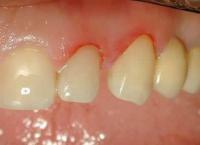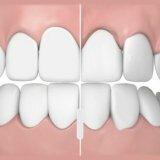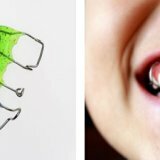Wedge-shaped defect
 A sphenoidal defect is a non-carious lesion that occurs on hard tissues of the teeth and localizes at the necks of the teeth, as well as on labial and cheek surfaces, most often canines and first premolars. Visually, this lesion manifests itself in the form of a step resembling a wedge( hence the wedge-shaped defect), which is formed in the cervical region. Such defects are expressed from a slight defect in the enamel, to the cleavage of the entire crown part. In most cases, a wedge-shaped defect is seen in middle-aged / older people.
A sphenoidal defect is a non-carious lesion that occurs on hard tissues of the teeth and localizes at the necks of the teeth, as well as on labial and cheek surfaces, most often canines and first premolars. Visually, this lesion manifests itself in the form of a step resembling a wedge( hence the wedge-shaped defect), which is formed in the cervical region. Such defects are expressed from a slight defect in the enamel, to the cleavage of the entire crown part. In most cases, a wedge-shaped defect is seen in middle-aged / older people.
. Causes of
. Today, the main cause of the appearance of a wedge-shaped defect has not been fully understood. However, most specialists are inclined to believe that this defect arises under the influence of various mechanical factors( including a toothbrush).There is an assumption that incorrect horizontal tooth cleaning with a toothbrush with stiff bristles leads to abrasion of hard tooth tissues, and since premolars and canines( the most protruding incisors in the dentition) most often suffer from the pathology of a wedge-shaped defect-this assumption is most likely. In addition, the factors that affect the appearance of this pathology include periodontitis and gum recurrence. The relationship of wedge-shaped defects to some somatic diseases, as well as to diseases of the psyche( schizophrenia, depression, neuroses, etc.) has been observed.
Symptoms of
The development of the wedge-shaped defect has been very slow for many years and in most cases pain is completely absent( patients only point outTo a slight defect in the neck of the tooth).In rare cases, sensitivity to sweetness, heat, cold, touch of the toothbrush and other irritants may manifest itself.
At a later stage, the sphenoid defect may increase to 3 mm, with the neck of the teeth becoming more sensitive. In the case of severe damage to the teeth, a wedge-shaped defect( of the order of 5 mm) affects already the deepest layers of the dentin, and sometimes the pulp chamber, which, even with a minimal load, leads to the chipping of the coronal part of the tooth.
Treatment of the wedge-shaped defect with its initial manifestations is aimed at stabilizationProcess( application of 2% sodium fluoride solution, 10% calcium gluconate solution, 75% fluoride paste) and elimination of traumatic factors( exclusion of abrasive toothpastes and powders, bristles with bristles, rejection of horizonsOnital reading of teeth).
If the wedge-shaped defects are clearly expressed, they are sealed, preferably composite fillings, as they can close the wedge-shaped defects without preliminary preparation. With deep defects, when it is possible to break the crown of the tooth, prosthetics is recommended.



